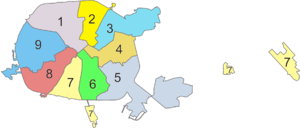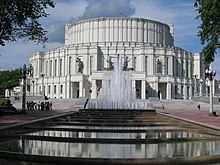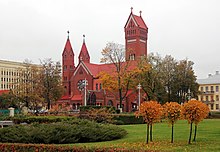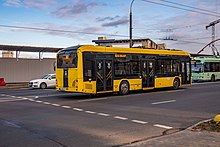Minsk
Minsk (Belarusian Мінск; Russian Минск) is the capital and largest city in Belarus. It is located in the center of the country, and is crossed by the Nyamiha and Svíslach rivers. It is the administrative seat of the Commonwealth of Independent States (CIS).
Minsk extends over an area of 509 km² in which, according to estimates for the year 2020, a total of 2,020,600 people live. As the capital of the State, Minsk has a special administrative status within Belarus and is also the capital of the Minsk Voblast and the homonymous district.
The first historical references to the city date back to 1067, when it was named as a provincial city in the Principality of Polotsk. The settlement developed on the rivers that run through it. In 1242, Minsk became part of the Grand Duchy of Lithuania and received the title of city in 1499.
Since 1569 it was the capital of the Minsk Voivodeship, in the Republic of Two Nations or Commonwealth of Poland-Lithuania. In 1793 it was one of the regions annexed by the Russian Empire as a consequence of the Second Partition of Poland. Between 1919 and 1991, after the Russian Revolution, Minsk was the capital of the Byelorussian Soviet Socialist Republic and later, in 1991, of Byelorussia after the dissolution of the Soviet Union.
Toponymy
Legend says that a giant named Menesk or Mincz had a mill on the banks of the river near the city. He ground the stones to make loaves with which he fed his warriors. The name "Minsk" perhaps comes from the Belarusian word Mensk, which derives from the word мена (miena 'change, change& #39;, in Spanish), based on the city's long commercial history.
History
In around the X century, Prince Rahvalod (or Rogvolod), of Viking origin, ruled a territory known as the Principality of Polatsk, to which the area occupied by the current city of Minsk belonged. The first written mention of the city under the name of Minsk appears in the year 1067, and is correlated with the dynastic struggle between the Principality of Polatsk and Kievan Rus.
Between the years 1101 and 1242 the city would be the epicenter of the Principality of Minsk, except for a brief period between 1129 and 1146 when it belonged to Kievan Rus. Subsequently, in 1326, Minsk fell under the rule of the Grand Duchy of Lithuania, a region that later became part of the Polish-Lithuanian Commonwealth, from which in 1499 it received its city privileges (Magdeburg Law). 1569 the city becomes the capital of the Minsk Voivodeship, an administrative division of the Grand Duchy. In 1655 during the Deluge Minsk was conquered by Tsar Alexios I of Russia, but was recaptured by King John II Casimir Vasa in 1667.
In 1793, the city was annexed to the Russian Empire, as a consequence of the second partition of Poland. In 1919 and 1920 the city was controlled by the Second Polish Republic, during the course of the Polish-Soviet War. The city is finally ceded to Russia through the Riga Peace Pact, and becomes the capital of the Byelorussian SSR, one of the republics that made up the USSR.
Much of the city was destroyed during German bombing in World War II. Indeed, during the German invasion of the USSR in 1941 (Operation Barbarossa), Minsk was immediately invaded. The city was bombarded by the Germans from the first day of the war and was invaded four days later. The Nazis turned the city into the administrative center of the Reichskommissariat Ostland and began to harshly repress the population, especially the communists and Jews. A Jewish ghetto of one hundred thousand people was built in Minsk. The city was liberated by the Soviets on July 3, 1944. By the end of the war, about 80% of the city was in ruins. Minsk was rebuilt in the Soviet style.
In the 1980s, the Chernobyl accident affected a large part of the southeast of the country, access to some areas is still restricted. The city was the capital of the Byelorussian SSR from 1919 until 1991, when it became the capital of the Republic of Byelorussia.
Minsk today is a large metropolis with predominantly Soviet-era architecture, but also modern buildings dating from after the fall of the USSR.
Geography
Minsk is located on the southeastern slope of the hills of the same name, a section of hills whose direction runs from the southwest in the upper Niemen River basin, to the northeast of Belarus, in the Lukomsko Lake to the northwest. The average altitude of the city is 220 m above sea level. Minsk's geography was formed during the two most recent ice ages.
The Svisloch River, which flows through the city from northwest to southeast, lies in the Urstromtal, an ancient river valley formed by flowing water from melting ice sheets in the late Last Age of Ice.
The original development of the city was on these hills, which allowed the easy construction of defensive fortifications. However, in the 20th century, it grew in a southeasterly direction including the surrounding relatively flat plains. The western part of the city is the most mountainous.
The predominant ecosystem in the city, as in the rest of the country, is the temperate broadleaf forest, present especially in the north and east of it. With the growth of the metropolis, some of the original forests were preserved as parks, highlighting the Chelyuskinites Park, for example.
Climate
Minsk has a humid continental climate (Köppen Dfb), due to its location between the strong influence of moist air from the Atlantic Ocean and dry air from the Eurasian landmass. Its climate is unstable and tends to change frequently. The average temperature in January is -4.5 °C, while in July it is 18.5 °C. The lowest temperature recorded was -40 °C on January 17, 1940, and the warmest was recorded on July 29, 1936 and was 35 °C. This results in frequent fogs in the fall and spring. Minsk receives an annual precipitation of 690 millimeters, of which one third is in the cold period (as snow and rain) and two thirds in the warm period. Throughout the year, winds blow from the west and northwest bringing cool, humid air from the Atlantic.
| Month | Ene. | Feb. | Mar. | Open up. | May. | Jun. | Jul. | Ago. | Sep. | Oct. | Nov. | Dec. | Annual |
|---|---|---|---|---|---|---|---|---|---|---|---|---|---|
| Temp. max. abs. (°C) | 10.3 | 13.6 | 18.9 | 28.8 | 30.9 | 35.8 | 35.0 | 35.8 | 31.0 | 24.7 | 16.0 | 11.1 | 35.8 |
| Average temperature (°C) | -2.0 | -0.8 | 4.5 | 12.8 | 18.9 | 22.4 | 24.3 | 23.6 | 17.5 | 10.3 | 3.6 | -0.6 | 11.2 |
| Average temperature (°C) | -4.2 | -3.6 | 0.7 | 7.6 | 13.4 | 17.1 | 19.1 | 18.2 | 12.7 | 6.7 | 1.4 | -2.6 | 7.2 |
| Temp. medium (°C) | -6.3 | -6.0 | -2.6 | 2.9 | 8.3 | 12.2 | 14.4 | 13.4 | 8.7 | 3.8 | -0.5 | -4.5 | 3.7 |
| Temp. min. abs. (°C) | -39.1 | -35.1 | - 30.5 | -18.4 | -5.0 | 0.0 | 4.3 | 1.7 | -4.7 | -12.9 | -20.4 | - 30.6. | -39.1 |
| Total precipitation (mm) | 47 | 40 | 41 | 43 | 66 | 79 | 97 | 71 | 51 | 55 | 49 | 47 | 686 |
| Nevadas (cm) | 11 | 16 | 13 | 0 | 0 | 0 | 0 | 0 | 0 | 0 | 2 | 6 | 48 |
| Days of rain (≥ 1 mm) | 11 | 9 | 11 | 13 | 18 | 19 | 18 | 15 | 18 | 18 | 17 | 13 | 180 |
| Days of snowfall (≥ 1 mm) | 24 | 21 | 15 | 4 | 0.3 | 0 | 0 | 0 | 0.04 | 3 | 13 | 22 | 102.3 |
| Hours of sun | 44 | 66 | 134 | 181 | 257 | 273 | 269 | 242 | 165 | 97 | 35 | 27 | 1790 |
| Relative humidity (%) | 86 | 83 | 77 | 67 | 66 | 70 | 71 | 72 | 79 | 82 | 88 | 88 | 77.4 |
| Source #1: Погода и климат | |||||||||||||
| Source No. 2: NOAA(Horas de sol, 1938 and 1945-2000) | |||||||||||||
Demographics
According to estimates made in 2012, 1,901,700 people live in the city, a figure that rises to 2,101,018 inhabitants in the metropolitan area. to approximately 20% of the total population in Belarus.
The ethnic distribution of the city shows that the main minority that inhabits the city is made up of Russian citizens and that they make up around 15% of the municipal population. Other notable minorities are the Ukrainian and Polish, which together account for 3% of the total.
| 1450 | 1654 | 1667 | 1790 | 1811 | 1813 | 1860 | 1897 | 1917 | 1941 | 1944 | 1959 | 1970 |
|---|---|---|---|---|---|---|---|---|---|---|---|---|
| 5,000 | 10,000 | 2,000 | 7,000 | 11,000 | 3,500 | 27,000 | 91,000 | 134,500 | 300,000 | 500,000 | 509.500 | 907.100 |
| 1979 | 1989 | 1999 | 2007 | 2009 | 2012 | |||||||
| 1.276,000 | 1.607,000 | 1,680,000 | 1.814,000 | 1.837,000 | 1.901,700 |
- The years in italics indicate that the population corresponds to an official census.
Administration
Minsk is a first-order municipality that is divided into small administrative units, organized in 1938, due to the great growth of the city. On March 17, 1938, three districts were established, Stalinsky (Zavodski since 1961), Varashylauski (Savetski since 1961) and Kahanovichski (Kastrychnitsky since 1957). Currently the city is divided into nine districts: Frunzenski, Kastrychnitski, Leninski, Maskouski, Partyzanski, Pershamayski, Savetski, Tsentralny and Zavodzki.
Districts
Currently Minsk is subdivided into 9 raions (districts):
- Tsentralny (in Belarusian, .in Russian, .or "Central Distrito"
- Savetski (in Belarusian, Савецкіin Russian, СоветскийSovetsky, or "Soviet Distrito"
- Pershamayski (in Belarusian, Першамайскіin Russian, ПервомайскийPervomaysky, in honor of May Day
- Partyzanski (in Belarusian, Партызанскіin Russian, ПартизанскийPartizansky, in honor of the Soviet Partisans
- Zavodski (in Belarusian, Zаводскіin Russian, ., Zavodskoy), or "Industrial Distrito" (industrial sede, and MTZ and MAZ factories)
- Leninski (in Belarusian, MILITATIONin Russian, MILITARYLeninsky, or "Lenin Distrito"
- Kastrychnitski (in Belarusian, Кастрычніцкіin Russian, ОктябрьскийOktyabrsky, or "Distrito de la Revolución de Octubre"
- Maskouski (in Belarusian, Масковскіin Russian, Московский, Moskovsky), or "Distrito de Moscow"
- Frunzenski (in Belarusian, Фрунскіin Russian, Фрунский, Frunzensky), or "Distrito de Mikhail Frunze"
There are also other microdistricts in the city that do not constitute an independent entity like the previous ones.
Economy
Minsk is the largest industrial center in Belarus. Its industrial development began in the 1860s, and was facilitated by the construction of railways in the 1870s. Much of the industry was destroyed during World War I and especially during World War II. After the war, the development of the city was directed towards industrial products. The city specialized in the production of tractors, gearboxes for vehicles, trucks, optical equipment, refrigerators, motorcycles, televisions, and radios, among other consumer goods.
Minsk also had an important textile, building materials, food processing and printing industries. Unlike other cities in the former Soviet Union, Minsk did not suffer the effects of deindustrialization in the 1990s. The city currently has just over 250 factories and 40% of the city's workforce is employed. employed in the manufacturing sector. About 70% of production is exported, especially to Russia and the CIS states. Currently unemployment and underemployment have increased and constitute one of the great problems of the local government.
Education
Minsk is the largest educational center in Belarus. It has approximately five hundred kindergartens, 258 schools, 28 secondary schools, and 36 higher education institutions, including twelve universities.
- Academy of Directors attached to the President of the Republic of Belarus: it is the main university in the national education system of the Republic of Belarus and the main educational institution in the training, retraining and professional overcoming of business managers. The academy was founded on 29 January 1991, in 1995 of the Academy of Directors the presidential status was appropriate. In the structure of the academy three institutes: Institute of Management Personnel has three powers, Institute of Public Officials also has three faculties and Institute for Scientific Research in Theory and Public Management Practice.
- Belarusian State University: is the largest university in Belarus, founded in 1921. To date, the university offers programs in fifteen faculties: applied mathematics and infoscience, biology, chemistry, geography, economy, international relations, journalism, history, humanitarian sciences, laws, mechanics and mathematics, philology, philosophy and social sciences, physics, radio-physics and electronics.
- State University of Agricultural Technology of Belarus: specialized in agricultural technology and machinery.
- Belarusian National Technical University: specialized in technological disciplines.
- Belarusian State Medical University: specialized in medicine and dentistry. Since 1921 he was a department of the Belarusian State University. In 1930 he became a separate entity known as Belarus Medical Institute. In 2000 he obtained a university degree. It currently has six departments.
- State University of Belarusian Economy: specialized in finance and economy. Founded in 1933 as Belarus Institute for the National Economy. Elevated to the university category in 1992.
- Universidad Estatal de Cultura y Arte Bielorrusos: specialized in cultural, visual and performing arts studies.
- Belarusian State Pedagogical University Maxim Tank: specialized in the training of secondary school teachers.
- Belarusian State University of Computer Science and Radio-electronic: specialized in IT and radio-electronic technologies. Established in 1964 as Minsk Radio-electronic Institute.
- Belarusian State University of Physical Training: specialized in training athletes and training trainers.
- Bielorrusa State Technological University: specialized in chemical and pharmaceutical technologies, printing and forest aspects. Founded in 1930 as Forestry Institute In Homel, in 1941 he was evacuated to Sverdlovsk (now Ekaterimburg). Returned to Gomel in 1944, but in 1946 relocated to Minsk as Belarus Institute of Technology. Elevated to the university degree in 1993. He currently has nine departments.
- Minsk State University of Linguistics: specialized in foreign languages, Founded in 1948 as the Institute of Foreign Languages of Minsk. In 2006 it has eight departments. Focused on English, German, French and Spanish.
- Andrei Sakharov State Environmental University: specialized in environmental sciences. Established in 1992 as a United Nations assistant. His main project is the study and search for the consequences of the Chernobyl catastrophe, which had great consequences in Belarus.
Culture
Minsk is the largest cultural center in Belarus. Its first theaters and libraries were inaugurated in the mid-XIX century. Currently there are eleven theaters and sixteen museums, as well as twenty movie theaters and one hundred and thirty-nine libraries. It is the headquarters of the National Library of Belarus.
- The most important theatres are:
- Comedy and Musical Theatre of Belarus.
- Opera and Ballet theater Belarusian.
- Teatro Nacional de Arte Dramatic Máximo Gorki (presentations in Russian).
- Yanka Kupala National Dramatic Art Theatre (presentations in Belarus).
- The main museums include:
- Museo de la Gran Guerra Patria.
- National Museum of Art of Belarus.
- Museum of History and Culture of Belarus.
- Natural Museum and the Environment of Belarus.
- Museum of Ethnography and Folklore.
- Maksim Bahdanovich Literary Museum.
- Museum of Ancient History of Belarus.
- Yanka Kupala Literary Museum.
- Minsk International Film Festival
Transportation
Minsk has an extensive public transport network. Passengers are served by 8 tram lines, more than 70 trolleybus lines, and more than 100 bus lines. Trams were the first public transport to be used in Minsk, dating from 1892 the horse-drawn tram, and from 1929 the electric tram. Public buses have been used since 1924 and the use of the trolleybus was introduced in 1952.
All public transportation is operated by Minsktrans, a government-owned company that is itself a non-profit organization. As of January 2008, Minsktrans operates 1,420 buses, 1,010 trolleybuses and 153 trams in Minsk.
The Minsk city government decreed in 2003 that local transport supply should be set at a minimum level of 1 vehicle (bus, trolleybus or tram) for every 1,500 inhabitants. Currently, the number of vehicles in use by Minsktrans is 2.2 times higher than the minimum level.
Public transport fares are controlled by the municipal executive committee (city hall). The cost of a single bus, trolleybus, tram or metro ticket is about 1,700 Belarusian rubles and about 2,400 in the case of express buses. There are also monthly passes for the use of these services at a cost of 72,900 and 131 400 BYR. On the other hand, another mode of transport that is widely used is the Marshrutkas, a type of community taxi that is quite common in the countries of the former Soviet Union.
Subway
Minsk is the only city in Belarus with an underground metro system. The construction of the subway began in 1977, shortly after the city reached the figure of one million people, and the first line was inaugurated in 1984 and had 8 stations. Since then, it has been extended into two lines: Moskovskaya and Avtozavodskaya, whose lengths are 12.2 and 18.1 km long, with 11 and 14 stations, respectively. On November 7, 2007, two new stations on the Moskovskaya Line were opened, and work continues on an area 5.2 km long, with three new stations opened in 2013.
There are plans for a network with a total of three lines (based on current expansion plans) and 58.3 km with 45 stations and 3 train depots. For this to happen, the third line must cut the city along the north-south axis, crossing the two existing ones and thus forming a typical Soviet triangle design. The construction of the third line began in 2011, after suffering delays. There are also some specular layout plans for a possible fourth line from the Vyasnyanka to Serabranka microdistrict.
Since 2007, the Minsk metro has 25 stations and 33 kilometers of tracks. On a normal school day, the Minsk metro is used by 800,000 passengers and in 2007 the total number of users was 262.1 million, making it the fifth most active of all those that made up the USSR (only behind Moscow, Saint Petersburg, Kiev and Kharkiv). During rush hour trains run every 2-2.5 minutes. The metro network has 3,200 employees.
Currently most urban transportation is being actively revamped and upgraded to modern standards. For example, all subway stations built after 2001 have passenger elevators with the platform at street level, which allows disabled passengers to use the new stations.
Intercity train and bus
Minsk is the largest transportation hub in Belarus, located at the junction of the Warsaw-Moscow railway (built in 1871) running from the southwest to the northeast of the city and the Liepāja-Romny line (built in 1873) and that goes from the northwest to the south. The first of these lines connects with Russia, Poland and Germany, and the second connects with Ukraine, Lithuania and Latvia. They pass each other at the Minsk-Passazhyrski railway station, the main railway station in Belarus. This station was built in 1873 as Vilenski vakzal. The initial wooden building was demolished in 1890 and rebuilt in stone. During World War II the Minsk railway station was completely destroyed and was rebuilt between 1945 and 1946 and serving until 1991. The new building of the Minsk-Passazhyrski railway station was built between 1991 and 2002. Its construction was delayed due to difficulties However, today Minsk has one of the most modern stations in the CIS. There are plans to move all commuter rail traffic from Minsk-Passazhyrski to the smaller stations, Minsk-Uskhodni (East), Minsk-Paudnyovy-(South) and Minsk-Paunochny (North), in 2020.
There are three intercity bus stations that link Minsk with the suburbs and other cities in Belarus and neighboring countries. The routes connecting Minsk with Moscow, Smolensk, Vilnius, Riga, kyiv and Warsaw have regular lines and schedules.
Air transportation
As far as air transport is concerned, the city has the Minsk International Airport located about 42 km east of the city. It was inaugurated in 1982 and it has a railway station that was inaugurated in 1987. It is an international airport that has flights to several countries in Europe and the Middle East.
Minsk-1, the city's first airport, opened in 1933 a few kilometers south of the historic center. In 1955 it became an international airport and in 1970 it served more than 1 million passengers.
From 1982 it was mainly used for domestic routes in Belarus and short-haul routes to Moscow, kyiv and Kaliningrad. Minsk-1 was expected to be closed in 2008 due to noise pollution in surrounding residential areas, but as of mid-2010 it was still in service. The land occupied by the airport is scheduled to be reclassified to be used for residential and commercial purposes, brought together under a company called Minsk-City.
Sports
As in the rest of the country, both ice hockey and soccer are very popular in Minsk, with both national and international teams standing out in the first of these sports, as well as the modern Minsk Arena where In addition, other sports are practiced and it has a large capacity for spectators. On the other hand, another very popular sport in the country is Bandy and in said pavilion matches and tournaments are also held.
As for football, the city has one of the most traditional teams in Eastern Europe, FK Dinamo Minsk, which also houses the Dinamo Stadium, the largest in the country, where the games are played. matches of European competitions of Belarusian clubs and which is also the headquarters of the Belarusian soccer team. Other teams are: FC Partizan Minsk, FK Krumkachy, FC Tarpeda Minsk, FC SKVICH Minsk, FC Dinamo-93 Minsk. FC Ataka Minsk and FC Orbita Minsk.
| Predecessor: |  European City 2019 | Successor: |
Twinned cities
Minsk has a network of twinning agreements with twenty cities in different countries. The following cities make up that network:
- Milan, Italy
- Caracas (Venezuela)
- Nottingham (United Kingdom, since 1957)
- Sendai (Japan, since 1973)
- Bangalore (India, since 1973)
- Lyon, France, since 1976
- Belo Horizonte (Brazil, since 1987)
- Detroit, United States
- Changchun, China, since 1992
- Łódź (Poland, since 1993)
- Bonn, Germany, 1993
- Eindhoven (Netherlands, since 1994)
- Dusambé (Tajikistan, since 1998)
- Chisináu (Moldavia, since 2000)
- Havana (Cuba, since 2005)
- Kathmandu (Nepal)
- Tehran (Iran, since 2006)
- Abu Dhabi, United Arab Emirates, since 2007
- Ankara, Turkey, since 2007
- Biskek (Kyrgyzstan, since 2008)
- Ho Chi Minh City (Vietnam, since 2008)
- Riga (Latvia, since 2009)
- Madrid, Spain
Notable people
Contenido relacionado
Ifni
Template:TTO
Template:PRY
Template:·Country (ps)
Template:·Country (hr)










